You would expect Soviet-era orchestras to provide bracing performances of Borodin’s quintessentially Russian symphonies, and in many ways Evgeny Svetlanov and the USSR Symphony deliver the goods. There’s the ever-distinctive woodwind timbre, the bright, blaring brass, and the highly-muscled string playing that gives Borodin’s music an especially bold, masculine profile. However, Svetlanov himself is surprisingly mild-mannered in Symphony No. 1, employing moderate tempos in the first movement and keeping the all-important timpani part well in the background. By contrast, Tjeknavorian’s prominently placed timpanist generates consistent excitement. Svetlanov’s strong point is his slow, swooning rendition of the achingly beautiful Andante, though he does a pretty good job in the vibrant finale as well.
Symphony No. 2 finds Svetlanov much more involved, in fact probably more than Borodin would have preferred. The first movement, a brilliant and tautly constructed drama of tension and release, all but loses its focus due to the conductor’s excessive rubato, wherein he pulls the music about like so much taffy. The treatment of the main thematic material is so ham-fisted (and the trombones so prominent) that the movement winds up sounding more like Liszt than Borodin. Svetlanov takes the same approach, thankfully to a far lesser degree (and with more convincing results), in the noble Andante, while his Finale achieves the right balance of celebration and seriousness–the latter evoked by the imposing central brass interlude.
The 1983 recording, despite the use of (early) digital technology, still suffers from a degree of dynamic limitation–however, this remastering offers clear sound overall. Ashkenazy’s fresh and feisty renditions on Decca remain a first choice among modern versions, but until BMG deigns to release Tjeknavorian’s complete set on CD (if it ever does!), Svetlanov’s authentically Russian version provides an alternative worth considering.
































